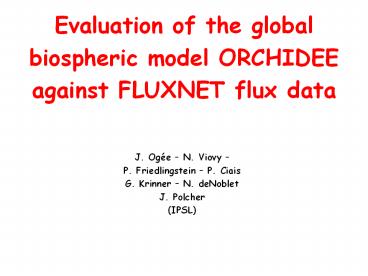Pr - PowerPoint PPT Presentation
1 / 18
Title:
Pr
Description:
IBIS. Annual GPP (Kg C m-2 y-1) CLASS-MCM. CLASS-UA. ORCHIDEE ... CLASS-UA. ORCHIDEE-1. ORCHIDEE-2. SWAP. IBIS. VISA. Total living biomass (Kg C/m-2) MC. AVIM ... – PowerPoint PPT presentation
Number of Views:34
Avg rating:3.0/5.0
Title: Pr
1
Evaluation of the globalbiospheric model
ORCHIDEEagainst FLUXNET flux data
J. Ogée N. Viovy P. Friedlingstein P.
Ciais G. Krinner N. deNoblet J. Polcher (IPSL)
2
Global biospheric model ORCHIDEE
NPP, biomass, litterfall
vegetation types
3
General framework for model evaluation
ORCHIDEE
FluxNet
4
FluxNet Network
More than 140 sites across the world (mainly N.
Hemisphere)
5
Sites used here
i.e. 31 sites, nearly 100 years of data
6
Meteorological forcing
Gap-filling method use of daily data
from - global radiation ECMWF ERA-15
analysis - other closest weather station
Tmax
temperature
Tmin
time
7
Site history
Hypothesis ecosystems in equilibrium
250 yrs
N yrs
SNEEmod 0 correction to account for measured
sink
mineral soil seeded (according to prescribed
vegetation distribution)
organic soil ecosystem equilibrium reached
N yrs of meteorological forcing
8
10-day bin-averaged fluxes (Tver forest)
Rn (W m-2)
H (W m-2)
LE (W m-2)
NEE (µmol m-2 s-1)
9
Daily and accumulated fluxes (Tver forest)
Rn (MJ m-2)
H (MJ m-2)
LE (MJ m-2)
NEE (gC m-2)
10
Seasonally (JJA) bin-averaged diurnal cycles
Rn (W/m2)
H (W/m2)
LE (W/m2)
NEE (µmol/m2/mth)
11
Bin-averaged seasonal cycles
Rn (MJ/m2/mth)
H (MJ/m2/mth)
LE (MJ/m2/mth)
NEE (gC/m2/mth)
12
Forêts tempérées vs. autres PFTs
ORCHIDEE pas trop mal sur les forêts
tempérées sauf les écosystèmes méditétannéens
13
Quelques résultats de PILPS Carbone
14
Slope/intercept and RMSE unsys/sysFor the
different models (3 hourly fluxes)
15
Index of agreement for all models
16
Modeled and simulated carbon net sink In 1997
and 1998
17
(No Transcript)
18
(No Transcript)































